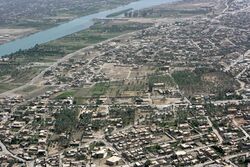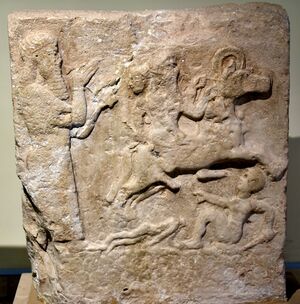الأنبار (مدينة)
Anbar
[الأنبار] Error: {{Lang}}: invalid parameter: |links= (help) | |
|---|---|
 | |
| الإحداثيات: 33°22.5′N 43°43′E / 33.3750°N 43.717°E[1] | |
| Country | Iraq |
| Governorate | Al Anbar |
الأنبار مدينة عراقية قديمة تقع ضمن أراضي مدينة الصقلاوية على الضفة الشرقية لنهر الفرات جنوب نهر الصقلاوية، أقصى شمال شبكة القنوات التي تمتد من نهر الفرات إلى نهر دجلة.
التاريخ
الأصول
 Assyrian wall relief showing a scribe and a horseman trampling enemies. من عنة، محافظة الأنبار، العراق. القرن 9–7 ق.م. المتحف العراقي |
تقع المدينة على الضفة اليسرى للفرات الأوسط، at the junction with the Nahr Isa canal, the first of the navigable canals التي تربط نهر الفرات إلى دجلة إلى الشرق.[1][2] The origins of the city are unknown, but ancient, perhaps dating to the Babylonian era and even earlier: the local artificial mound of تل أسود يعود إلى ح. 3000 ق.م..[1]
العصر الساساني
The town was originally known as Misiche (Greek: Μισιχή), Mesiche (Μεσιχή), or Massice (الفارسية المتوسطة: 𐭬𐭱𐭩𐭪 mšyk; پارثية: 𐭌𐭔𐭉𐭊 mšyk).[2][3] As a major crossing point of the Euphrates, and occupying the northernmost point of the complex irrigation network of the Sawad, the town was of considerable strategic significance.[1] As the western gate to central Mesopotamia, it was fortified by the Sasanian ruler Shapur I (ح. 241–272) to shield his capital, Ctesiphon, from the Roman Empire.[1] After his decisive victory over the Roman emperor Gordian III at the Battle of Misiche in 244, Shapur renamed the town to Peroz-Shapur (Pērōz-Šāpūr or Pērōz-Šābuhr, from الفارسية المتوسطة: 𐭯𐭥𐭩𐭥𐭦𐭱𐭧𐭯𐭥𐭧𐭥𐭩, meaning "victorious Shapur"; in پارثية: 𐭐𐭓𐭂𐭅𐭆𐭔𐭇𐭐𐭅𐭇𐭓, romanized: prgwzšhypwhr; in بالأرامية: פירוז שבור).[2][3] It became known as Pirisapora or Bersabora (باليونانية قديمة: Βηρσαβῶρα) to the Greeks and Romans.[1]
The city was fortified by a double wall, possibly through the use of Roman prisoner labour; it was sacked and burned after an agreement with its garrison in March 363 by the Roman emperor Julian during his invasion of the Sasanian Empire.[2][4] It was rebuilt by Shapur II.[4] By 420, it is attested as a bishopric,[2] both for the Church of the East and for the Syriac Orthodox Church.[1] The town's garrison was Persian, but it also contained sizeable Arab and Jewish populations.[1] Anbar was adjacent or identical to the Babylonian Jewish center of Nehardea (بالأرامية: נהרדעא), and lies a short distance from the present-day town of Fallujah, formerly the Babylonian Jewish center of Pumbedita (بالأرامية: פומבדיתא).
الأنبار تسمى بالفارسية فيروز شابور وتعني باللغة الفارسية شابور المنتصر وكان اليونانين والرومان يسمونها بيرسابورا. أنشأت المدينة عام 350 بعد الميلاد بيد الأمبراطور الساساني شابور الثاني ملك فارس وكانت تقع ضمن محافظة أشورستان أحرقت المدينة بيد الأمبراطور الروماني يوليان في نيسان/أبريل 363 (ب.م)خلال غزوه الإمبراطورية الساسانية.[5] وأصبحت المدينة ملجأ للعرب والمسيحين واليهود. وطبقاً للمصادر التاريخية العربية فأن قسم من سكانها هاجروا شمالاً ليؤسسوا مدينة الحضر جنوب الموصل.
ومدينة الأنبار مجاورة أو هي نفسها مدينة اليهود البابلين (نهاريا) كما تجاور مدينة بامديثيا اليهودية القديمة، وتقع على مسافة قريبة من مدينة الفلوجة الحالية.
العصر الإسلامي
بعد فتح الحيرة عام 11 هـ، انتظر المسلمون سنة كاملة حتى أذن لهم الخليفة أبو بكر الصديق بغزو الأنبار. تقدم جيش المسلمين بقيادة خالد بن الوليد فلما علم أهل الأنبار بزحف المسلمين حفروا خندقاً وتحصنوا بإسوار المدينة وقعدوا ينتظرون قدومهم.وجرت بين الطرفين معركة الإنبار عام 12هجرية الموافق 633 م والتي لم تسفر عن نصر حاسم لاحد الطرفين، فطلب اهلها الصلح فصالحهم خالد بن الوليد.
تغيير اسم المدينة إلى الأنبار (وهو أسم فارسي معناه المسستودع)عندما اتخذها مؤسس الدولة العباسية أبو العباس السفاح عاصمة له، وبقيت عاصمة لأخيه وخليفته أبو جعفر المنصور حتى بناء مدينة بغداد سنة 762 م.وبقيت المدينة محافظة على أهميتها طوال لعصر العباسي.
The city fell to the Rashidun Caliphate in July 633, after a fiercely fought siege.[4] When Ali ibn Abi Talib (r. 656–661) passed through the city, he was warmly welcomed by ninety-thousand Jews who then lived there, and he "received them with great friendliness."[6]
The Arabs retained the name (Fīrūz Shābūr) for the surrounding district, but the town itself became known as Anbar (Middle Persian word for "granary" or "storehouse") from the granaries in its citadel, a name that had appeared already during the 6th century.[1][7] According to Baladhuri, the third mosque to be built in Iraq was erected in the city by Sa'd ibn Abi Waqqas.[8] Ibn Abi Waqqas initially considered Anbar as a candidate for the location of one of the first Muslim garrison towns, but the fever and fleas endemic in the area persuaded him otherwise.[8]
According to medieval Arabic sources, most of the inhabitants of the town migrated north to found the city of Hdatta south of Mosul.[9] The famous governor al-Hajjaj ibn Yusuf cleared the canals of the city.[8]
Abu'l-Abbas as-Saffah (ح. 749–754), the founder of the Abbasid Caliphate, made it his capital in 752, constructing a new town half a farsakh (ح. 2.5 كيلومتر (1.6 mi)) to the north for his Khurasani troops. There he died and was buried at the palace he had built. His successor, al-Mansur (ح. 754–775), remained in the city until the founding of Baghdad in 762.[8][10] The Abbasids also dug the great Nahr Isa canal to the south of the city, which carried water and commerce east to Baghdad.[8][11] The Nahr al-Saqlawiyya or Nahr al-Qarma canal, which branches off from the Euphrates to the west of the city, is sometimes erroneously held to be the Nahr Isa, but it is more likely that it is to be identified with the pre-Islamic Nahr al-Rufayl.[8]
It continued to be a place of much importance throughout the Abbasid period.[12] Caliph Harun al-Rashid (ح. 786–809) stayed at the town in 799 and in 803.[8] The town's prosperity was founded on agricultural activities, but also on trade between Iraq and Syria.[8] The town was still prosperous in the early 9th century, but the decline of Abbasid authority during the later 9th century exposed it to Bedouin attacks in 882 and 899. In 927, the Qarmatians under Abu Tahir al-Jannabi sacked the city during their invasion of Iraq, and the devastation was compounded by another Bedouin attack two years later.[8] The town's decline accelerated after that: while the early 10th-century geographer Istakhri still calls the town modest but populous, with the ruins of the buildings of as-Saffah still visible, Ibn Hawqal and al-Maqdisi, who wrote a generation later, attest to its decline, and the diminution of its population.[8]
The town was sacked again in 1262 by the Mongols under Kerboka.[8] The Ilkhanids retained Anbar as an administrative centre, a role it retained until the first half of the 14th century; the Ilkhanid minister Shams al-Din Juvayni had a canal dug from the city to Najaf, and the city was surrounded by a wall of sun-dried bricks.[8]
التاريخ الكنسي
كانت المدينة مقر لأسقفية تتبع كنيسة المشرق.وأسماء 14 من الأساقفة الذين جلسوا على كرسي أسقفية الأنبار بين 486م-1074م معروفة، ثلاثة منهم أصبحوا بطارقة.[13] ولم تستمر الأنبار مقراُ لأسقفية لما بعد القرن الحادي عشر.واليوم الأنبار مسجلة عند الكنيسة الكاثوليكية تحت الرعاية الأسمية ل الكنيسة الكلدانية الكاثوليكية.[14] The names of fourteen of its bishops of the period 486–1074 are known, three of whom became Chaldean Patriarchs of Babylon.[15]
- Narses اِزد. 540
- Simeon اِزد. 553
- Salibazachi اِزد. 714
- Paul اِزد. 740
- Theodosius
- John اِزد. 885
- Enos 890
- Elias اِزد. 906-920
- Jaballaha اِزد. 960
- Sebarjesus
- Elias II اِزد. 987
- Unnamed bishop اِزد. 1021
- Mundar اِزد. 1028
- Maris اِزد. 1075
- Zacharias اِزد. 1111
القاصد الرسولي
Anbar is listed by the Catholic Church as a titular see of the Chaldean Catholic Church,[16] established as titular bishopric in 1980.
It has had the following incumbents:
- Titular Archbishop Stéphane Katchou (1980.10.03 – 1981.11.10), as Coadjutor Archeparch of Bassorah of the Chaldeans (Iraq) (1980.10.03 – 1981.11.10)
- Titular Bishop Ibrahim Namo Ibrahim (1982.01.11 – 1985.08.03), as Apostolic Exarch in the United States of America (1982.01.11 – 1985.08.03)
- Titular Bishop Shlemon Warduni (since 2001.01.12), Curial Bishop of the Chaldean Catholic Church
الحالة الراهنة
المدينة اليوم مهجورة كلياً، ومشغولة بأكوام من الخرائب والأنقاض تشير إلى أهمية المدينة في الماضي.
المصادر
- ^ أ ب ت ث ج ح خ د ذ Streck & Duri 1960, p. 484.
- ^ أ ب ت ث ج Brunner 1975, p. 759.
- ^ أ ب Frye 1983, p. 125.
- ^ أ ب ت ODLA, "Peroz-Shapur" (J. Wienand), p. 1159.
- ^ G. W. Bowersock, Julian the Apostate, (Harvard University Press, 1978), 112.
- ^ Sherira Gaon (1988). The Iggeres of Rav Sherira Gaon (in الإنجليزية). Translated by Nosson Dovid Rabinowich. Jerusalem: Rabbi Jacob Joseph School Press - Ahavath Torah Institute Moznaim. p. 125. OCLC 923562173.
- ^ Le Strange 1905, pp. 65–66.
- ^ أ ب ت ث ج ح خ د ذ ر ز س Streck & Duri 1960, p. 485.
- ^ Lewis, Bernard (1986). "Ḥadīt̲a". In Hertzfeld, E (ed.). Encyclopaedia of Islam. Vol. 3 (Second ed.). BRILL. p. 29. ISBN 9789004081185. Retrieved 12 October 2012.
- ^ Le Strange 1905, p. 66.
- ^ Le Strange 1905, pp. 66–67.
- ^ Peters 1911.
- ^ Michel Lequien, Oriens christianus in quatuor Patriarchatus digestus, Paris 1740, Vol. II, coll. 1171-1174 Archived 2017-10-19 at the Wayback Machine
- ^ Annuario Pontificio 2013 (Libreria Editrice Vaticana 2013 ISBN 978-88-209-9070-1), p. 832
- ^ قالب:Oriens christianus
- ^ Annuario Pontificio 2013 (Libreria Editrice Vaticana 2013 ISBN 978-88-209-9070-1), p. 832
- كتاب الموسوعة العسكرية (ج1).
- Pages using gadget WikiMiniAtlas
- Short description is different from Wikidata
- Lang and lang-xx template errors
- Coordinates on Wikidata
- Articles containing Ancient Greek (to 1453)-language text
- Articles containing Middle Persian-language text
- Articles containing پارثية-language text
- Pages using Lang-xx templates
- Articles containing Imperial Aramaic (700-300 BCE)-language text
- أماكن مأهولة سابقا في العراق
- أماكن مأهولة في محافظة الأنبار
- الدولة العباسية
- العراق في العصور الوسطى
- تاريخ الشرق الأوسط
- عواصم آسيا
- محافظة الأنبار
- مدن قديمة
- معالم مسيحية
- مواقع أثرية في العراق
